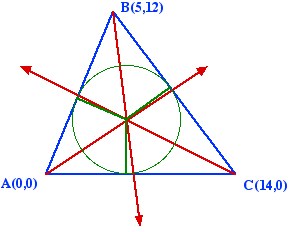
Math 5-335 Fall 2003
Supplementary exercises for the October 23 homework
Supplementary problem #3 Consider the triangle shown in the following figure:

Supplementary exercise #4 Given triangle
![]() ABC,
let P be the midpoint of
ABC,
let P be the midpoint of
![]() , let
Q be the midpoint of
, let
Q be the midpoint of
![]() , and let
R be the midpoint of
, and let
R be the midpoint of
![]() .
.

Supplementary exercise #5 Given triangle
![]() ABC
and triangle
ABC
and triangle
![]() PQR. Assume that
there exists a nonzero
real number v such that:
PQR. Assume that
there exists a nonzero
real number v such that:
|![]() | = v |
| = v |![]() |
|
|
|![]() | = v |
| = v |![]() |
and
|
|
and
|![]() | = v |
| = v |![]() |.
|.
Show that if the orthocenter of triangle
![]() ABC
is (r,s,t)
ABC
is (r,s,t)![]() ABC, then the orthocenter of triangle
ABC, then the orthocenter of triangle ![]() PQR is
(r,s,t)
PQR is
(r,s,t) PQR. ( We use
the notations ABC and PQR as part of
the superscript to indicate the triangle relative to which we are taking
the barycentric coordinates . . . )
PQR. ( We use
the notations ABC and PQR as part of
the superscript to indicate the triangle relative to which we are taking
the barycentric coordinates . . . )
Suggestion: Refer to the formula from Theorem 7 of Chapter 3
of the text. What power of v can be factored from
the numerators and from the denominators?
( It's useful to note here that the numerators and
denominators in the formula given in Theorem 7 are homogeneous
polynomials: this means that all of the monomials occurring in
one of these polynomials have the same total degree.
For instance,
2x3 + 3y3 + 5z3 + 11xyz is homogeneous of degree 3.
)
Note: The assignment also includes problems #7 and #11 from Chapter 3 of the text.
Comments and questions top;
roberts@math.umn.edu
Back to to the homework list.
Back to the class homepage.